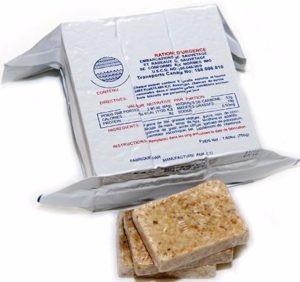Survival food bars are a dense high-calorie food for disaster situations. They’re compact, efficient and require no preparation, making them an essential part of your emergency food supply.
In this article, we’ll discuss the pros and cons of ration bars, why they shouldn’t be the only food you rely on, and, of course, which ones to buy!
Our Top Pick
Survival Frog Emergency Bars
Individually wrapped for convenience and pretty much indestructible. These bars are ideal as a last resort food solution.Check On Survival Frog
Pros and Cons of Survival Food Bars
Pros
Very calorie dense – don’t take up much storage space
Don’t require water to digest
Don’t require any cooking or preparation
Long shelf life
Inexpensive
Almost indestructible (if you get desperate, some of the blocks could come in handy as an improvised weapon)
Cons
Provide enough calories for survival but not day-to-day activities
Blocks are heavy – not ideal for your Bug Out Bag
No real nutritional value so not good to rely on for the long term
Boring to eat (though if you’re in a position where you have to eat them, you probably have bigger things to worry about!)
Our Top Five Survival Bars
Survival Frog 3600 Emergency Food Ration
Pack size: 9 bars | Weight: 24.8 oz | Calories per serving: 400 | Shelf-life: 5 years
Approved by the US Coastguard for survival on land or sea, you’d expect the Survival Frog rations to be pretty much indestructible. Each bar is individually wrapped, and the block of bars is vacuum bagged in tough polymer-foil.
They’re designed to be chucked in the hull of a lifeboat for years, so the package should be pretty resilient to heat, saltwater and other nasties.
Check Prices on Survival Frog

Each bar is 400 calories. The bars can be eaten solid or mixed with water, though I’m not sure that would make them any more appealing.
The ingredients list is basic: flour, vegetable shortening, sugar, water and coconut flavor. They’re less sweet than other bars and as most of the carbs come from flour, they won’t give you as much of a sugar rush and slump.
Texture wise, they’re very dry and crumbly, so even though they’re designed not to provoke thirst, you’re likely to find yourself wishing you had water to hand. This also makes them tricky to unwrap without your precious calories crumbling off and falling to the floor.
Pros
Individually wrapped bars
Nut free and non-GMO
Low cost per calorie
Cons
Hard to unwrap individual bars
No added vitamins
Mainstay Emergency Rations
Pack size: 9 bars/3 days | Weight: 24 oz | Calories per serving: 400 | Shelf-life: 5 years
The Mainstay bars are very similar to the Datrex bars in composition, with some added flavoring and vitamins. These are the best bars in terms of vitamin content, though it’s worth noting that they’re lower in protein, which may be more of a priority in a short-term survival situation.
Check Prices on Amazon

They’re supposed to have a buttery lemon flavor that makes me think of lemon shortbread (yum!). As you might expect, they don’t quite live up to this, though they’re not that bad, particularly given they have a relatively low sugar content.
Like the Mayday rations, Mainstay’s survival bars come in large blocks which you break into individual portions, so the same advice about packing extra bags applies. They have a 5-year shelf life, but Mainstay also gives a temperature range of -40° F to 300°F. These bars are far more likely to survive the apocalypse than you!
Pros
Good range of vitamins and minerals
Low in sugar
Resilient packaging
Halal and Kosher certified
Cons
Portions aren’t individually wrapped
Low in protein
Mayday 2400 Emergency Food Rations
Pack size: 6 bars/2 days | Weight: 18 oz | Calories per serving: 400 | Shelf-life: 5 years
Mayday’s emergency rations come in various sized packs from a single serving 400-calorie bar up to a 3-day supply. This gives a lot more flexibility than other brands which typically come in one or two sizes.
Check Prices on Amazon

They’re one of the better tasting bars with a hint of apple and cinnamon flavor (though still fairly bland). In terms of ingredients, they’re very similar to the Mainstay bars and the main reason to choose between the two comes down to personal taste.
The Mayday bars have more protein per serving but fewer vitamins and minerals. The higher protein content will help you feel fuller and you’re unlikely to suffer too much from a lowered vitamin intake for a few days (remember, these aren’t designed to be a long-term emergency food).
Mayday gives a temperature rating of -22° F to 149°F for the bars (if left outside), which pretty much covers any survival situation.
The big downside of these ration bars is the packaging. The bars come in one big block and you break off a portion at a time. As you can’t reseal the pack, once you’ve opened it, your food is exposed to the elements. For this reason, it’s worth keeping a couple of resealable bags with your emergency rations to protect what you don’t eat right away.
Pros
Flexibility in pack size
Resilient packaging
Decent flavor
Low in sugar
Cons
Portions aren’t individually wrapped
Limited vitamins and minerals
Food Labs Millennium Bars
Pack size: 6 bars/2 days | Weight: 17.8 oz | Calories per serving: 400 | Shelf-life: 5 years
Unlike most ration blocks, the Millennium bars are individually vacuum-packed making them look a bit like sports or granola bars. This makes it easier to stash a couple in your Bug Our Bag or car glove compartment, but if you want to store a couple of days supply, you’ll need to bag them up yourself.
Check Prices on Amazon

A plus point is that they come in different flavors (Lemon, Raspberry, Blueberry, Cherry, Tropical fruit and Orange) which may make them more appealing to kids (and let’s face it, most of us adults too). The raspberry and blueberry bars are the best taste-wise but none of them quite live up to what our modern palettes expect.
Compared to the Datrex bars, these have a huge ingredients list – topped by sugar. Sugars make up just over 40 percent of each bar by weight. This makes them sweeter than other bars, but all that sugar is going to make you crash hard. I’d personally go for rations with longer-lasting carbs. On the plus side, they do contain various vitamins and minerals.
Pros
Different flavors
Individually packaged so good for Bug Out Bags
Fortified with vitamins
Cons
Expensive
Take up more space than blocks
High in sugar
SOS Emergency Food Rations
Pack size: 9 bars/3 days | Weight: 26.7 oz | Calories per serving: 410 | Shelf-life: 5 years
The 3-day pack consists of individually wrapped servings of 410 calories – a smidgeon higher than other bars. They’re supposed to taste like coconut cookies and they definitely do taste sweet, mainly because they are full of sugar.
Check Prices on Amazon

Sugar is a cheap fast way of giving you calories, but the resulting sugar slump is not going to help your mood. The vitamin content is low but, along with the Millennium bars, they have the highest amount of protein at 8g per serving.
Once you open the main packaging, the individual bars feel kind of slimy. This makes the bars difficult to open and the greasy feeling continues inside. Overall, they don’t taste too dreadful, but there are better bars out there.
Pros
Individually wrapped servings
Reasonably priced
Cons
High in sugar
Lacking in vitamins
Feels greasy
Ration Bars vs Energy Bars vs Emergency Meals
They may all be labeled as “emergency food” but what’s the difference between survival food bars, sports or energy bars and emergency meals?
When we talk about emergency meals, we’re referring to nutritionally balanced food that gives you the calories, protein, fat and vitamins and minerals to help you live normally for an extended period. MREs, tins of soup, and rice and beans all fit into this category.
We’ve written extensively about these options so head to the posts below to learn more:
- Foods which don’t require refrigeration
- Foods with a long shelf life
- Prepper’s guide to canned food shelf life
- Survival foods list
- Best emergency food reviews
Ration bars are designed to provide a minimum number of calories for survival – usually 1200 calories a day (about half of the recommended daily amount for adult men). They don’t require water to cook or digest and won’t make you thirsty, so they are good for situations when safe drinking water may be limited.
They are NOT designed to provide you with the regular number of calories you’re used to operating on, particularly if you’re an active person. Neither are they intended for you to live off for long periods as there is little nutritional value in the bars.
Put simply, survival bars are a disaster food of last resort. If you’re trapped without other food or don’t have water or fuel to prepare the food you do have, they could save your life.
So how do they differ from energy bars?
Well, unlike energy bars that are designed to be tasty (otherwise who would buy them?), historically, ration bars were designed to be anything but tasty. The idea was that you’d only eat them if you were really desperate and you wouldn’t be tempted to overeat.
Modern ration bars are a little better – boring rather than inedible – but as each “meal” will be identical to the last, you’re not going to be looking forward to this bland diet.
How Survival Bars Fit into Your Food Supply
We recommend stockpiling at least a 30-day supply of emergency food, consisting of breakfasts, lunches, dinners and snacks. This will get you through the early days of a disaster when you’re at home or if you retreat to a Bug Out location (presuming you’ve stocked your But Out location in advance).
You might think that ration bars are ideal to keep in your Bug Out Bag, but there are a couple of reasons why this isn’t the case.
First, they are heavy and as the bars are packaged together in one block (except for the Millennium bars), it makes them a little awkward to pack.
You could, of course, repackage the bars in Mylar bags, but generally, it’s best to keep the packs sealed until you need them.
Find out more about what food to pack in your Bug Out Bag in this article.
How to Store
All of the bars we’ve reviewed have a five-year expiration date. In a SHTF situation, they’re likely to be safe to eat for longer than this, but it’s always sensible to rotate your food supplies.
One of the advantages of ration bars is that they’re less sensitive than other foods to environmental factors. Although they’re best stored in a dry cool place, they should still be edible even if left outside in all weather conditions.
Because they have a long shelf life and don’t take up much space, it’s easy to stash a couple of packs in different locations you may end up in during a disaster.
For example, you may have packs at home, in your car emergency kit, at your designated Bug Out Location and at the homes of people you regularly visit, such as parents or other relatives.



No such thing as too many options. Thanks.